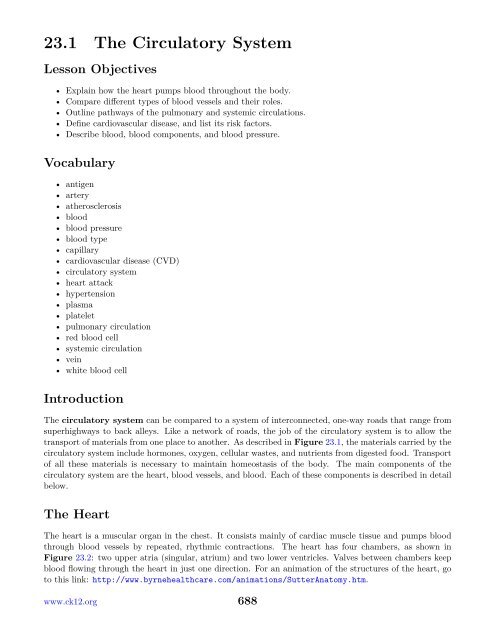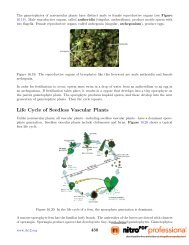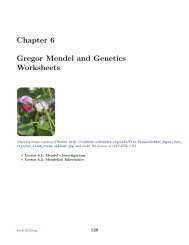Chapter 23 The Circulatory, Respiratory, Digestive, and Excretory ...
Chapter 23 The Circulatory, Respiratory, Digestive, and Excretory ...
Chapter 23 The Circulatory, Respiratory, Digestive, and Excretory ...
You also want an ePaper? Increase the reach of your titles
YUMPU automatically turns print PDFs into web optimized ePapers that Google loves.
<strong>23</strong>.1 <strong>The</strong> <strong>Circulatory</strong> System<br />
Lesson Objectives<br />
• Explain how the heart pumps blood throughout the body.<br />
• Compare different types of blood vessels <strong>and</strong> their roles.<br />
• Outline pathways of the pulmonary <strong>and</strong> systemic circulations.<br />
• Define cardiovascular disease, <strong>and</strong> list its risk factors.<br />
• Describe blood, blood components, <strong>and</strong> blood pressure.<br />
Vocabulary<br />
• antigen<br />
• artery<br />
• atherosclerosis<br />
• blood<br />
• blood pressure<br />
• blood type<br />
• capillary<br />
• cardiovascular disease (CVD)<br />
• circulatory system<br />
• heart attack<br />
• hypertension<br />
• plasma<br />
• platelet<br />
• pulmonary circulation<br />
• red blood cell<br />
• systemic circulation<br />
• vein<br />
• white blood cell<br />
Introduction<br />
<strong>The</strong> circulatory system can be compared to a system of interconnected, one-way roads that range from<br />
superhighways to back alleys. Like a network of roads, the job of the circulatory system is to allow the<br />
transport of materials from one place to another. As described in Figure <strong>23</strong>.1, the materials carried by the<br />
circulatory system include hormones, oxygen, cellular wastes, <strong>and</strong> nutrients from digested food. Transport<br />
of all these materials is necessary to maintain homeostasis of the body. <strong>The</strong> main components of the<br />
circulatory system are the heart, blood vessels, <strong>and</strong> blood. Each of these components is described in detail<br />
below.<br />
<strong>The</strong> Heart<br />
<strong>The</strong> heart is a muscular organ in the chest. It consists mainly of cardiac muscle tissue <strong>and</strong> pumps blood<br />
through blood vessels by repeated, rhythmic contractions. <strong>The</strong> heart has four chambers, as shown in<br />
Figure <strong>23</strong>.2: two upper atria (singular, atrium) <strong>and</strong> two lower ventricles. Valves between chambers keep<br />
blood flowing through the heart in just one direction. For an animation of the structures of the heart, go<br />
to this link: http://www.byrnehealthcare.com/animations/SutterAnatomy.htm.<br />
www.ck12.org 688





